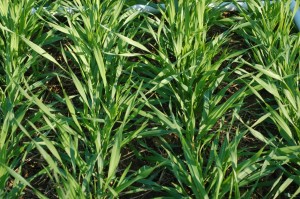 As soils warm in the spring, rising temperatures signal the crowns of winter annuals and perennials to break winter dormancy, and they begin a period of rapid, temperature-responsive growth, a process known as “spring green-up”. Along with that flush of growth comes the need for large amounts of readily available nutrients. When properly managed, winter annual small grains can grow 2-4 tons of additional dry matter in the short time between green-up and the time of forage harvest. Our perennial grasses can produce 1 to 3 tons of dry matter by first cutting, which typically occurs a few weeks after the time that we are harvesting the small grain forages.
As soils warm in the spring, rising temperatures signal the crowns of winter annuals and perennials to break winter dormancy, and they begin a period of rapid, temperature-responsive growth, a process known as “spring green-up”. Along with that flush of growth comes the need for large amounts of readily available nutrients. When properly managed, winter annual small grains can grow 2-4 tons of additional dry matter in the short time between green-up and the time of forage harvest. Our perennial grasses can produce 1 to 3 tons of dry matter by first cutting, which typically occurs a few weeks after the time that we are harvesting the small grain forages.
It’s generally advisable to add the bulk of your nutrients in spring. With small grains, a fall application of some nitrogen, or having some nitrogen available from manure sources in fall is beneficial for tiller development which ultimately can lead to heavier yields in the spring. However, too much fall nitrogen causes excessive fall growth; greater than 6 inches of growth before winter can leave the crop vulnerable to winter damage and snow mold.
Supplying enough spring N – 70 to 100 lbs/Acre, depending on the previous crop and history of manure in the field – can help increase crude protein content of the forage up to 20% of dry matter if it is harvested at flag leaf stage. (But be careful with too much N – a CP over 20% in small grain forages may signal high nitrates, a health hazard to animals.)
Spring nitrogen application should be targeted to be available just as the crops begin rapid growth and need it most. Too early and much of your application can be lost, especially on thin or light soils where heavy rainfalls follow the application. Liquid fertilizer applied right at green-up will be more readily available and effective than dry fertilizers, but at most locations spring rains are adequate to dissolve and move dry fertilizers into the root zone.
In high rainfall areas or on lighter, sandy, shaley soil where there is high leaching potential, you may need to split your spring nitrogen application so it is more efficiently drawn by the crop.
De-hardening
“De-hardening” begins when small grain crown tissue gets the signal to break dormancy as the plant’s crown reaches a temperature of 45-48 degrees F. From here, N application supports tiller growth and more vegetative growth. Growth rate increases the more temperatures rise.
Spring tillering and growth depends not only on proper fertilization, but also proper timing of fall planting. Late-planted forages won’t tiller as much in the spring, and those that were planted too early likely grew too much in the fall and possibly suffered more winter injury and dieback, reducing spring resiliency.
Making up the deficit now
The available N portion of any fall manure application depends on the type of manure (dairy, poultry, swine), as well as the consistency (solid, semi-solid, liquid). Manure is a valuable nutrient resource but there are huge variations in the manure from different livestock and also in different handling and storage systems. Periodic manure analysis is recommended for more accurate insight to manage manure nutrients. In manure with a higher straw or solid bedding contents, the carbon to nitrogen (C:N) ratio will be higher, tying up N and making it less readily available. Mineralization of organic N compounds is temperature-dependent, and a good percentage of it is released after temperatures have warmed and the winter-annual forage crop has already been harvested. This means that you need to compensate at green-up time or just before , with N that will be available at green-up and shortly thereafter. Ammonium sulfate is ideal at green-up time because it contains both nitrogen and sulfur, both critical for protein synthesis. Sulfur is also important for efficient nitrogen uptake and use. Like a nitrogen deficiency, sulfur deficiency can manifest as chlorosis, or leaf yellowing.
Before coal-burning plants adapted smokestack scrubbers to clean emissions, much more sulfur was deposited into soil through acid rain. Soil sulfur levels have consequently been on the decline, and more rapidly in fields in which forage is grown than grain (as more of the plant – and more nutrients – are removed in a forage crop).
Other nutrients
Soil types with a low CEC (Cation Exchange Capacity) – lighter, sandier soils – don’t hold onto and store high levels of nutrients like potassium and magnesium as well as higher CEC type soils. In these type soils, deficiencies may develop more quickly. An addition of K-Mag (Potassium and Magnesium) or a Sul-Po Mag (Sulfur, Potassium and Magnesium) type fertilizer combinations at greenup can be a good addition in soils that are low in these nutrients. High CEC soils are often heavier, higher in organic matter, and often don’t show the same deficiencies as quickly as lighter soils. Regular soil testing can give you an accurate picture of what soil nutrients are being drawn down over time and which are needed.
Manganese deficiencies present symptoms that resemble winter injury or windburn. Winter barley is among the more susceptible crops to this deficiency. If a spring N application stimulates rapid growth in the presence of a manganese deficiency, plants may suffer severe damages.
A soil pH of 6.5-6.8 should also be carefully maintained and monitored, again through periodic soil tests, as nutrients are most available within this range.
What about perennials?
Pastures and hayfields of course experience a green-up period of growth in the spring as well, in which they need certain levels of available nutrients to push rapid growth in response to rising spring temperatures. Usually these fields are amended in the late summer or fall, and the established root system has taken up and stored much of the energy and nutrients it needs to begin spring growth. It is of course important to push growth, but you may only need 30-40 units of N at green up time, depending on the perennial species composition, with the higher yielding orchardgrass and tall fescue varieties utilizing more. Perennials typically don’t produce quite as much dry matter in the first cutting as winter annual small grain forages. They don’t have the same race to put on the majority of their growth and reach reproduction in those spring months as do the winter annuals, so the nutrient load should be matched to productivity accordingly. Also, perennial grasses are often growing a few weeks longer and later into the season before first cutting, and at this time the soil temperatures continue to rise and organic compounds begin to mineralize, which will liberate some nitrogen and other nutrients for the growing perennial grasses to utilize.
Late summer is usually the best time to soil test and amend pastures and hayfields for various deficiencies.
Speak to an expert at King’s AgriSeeds now at 1-717-687-6224 or email us at [email protected].
